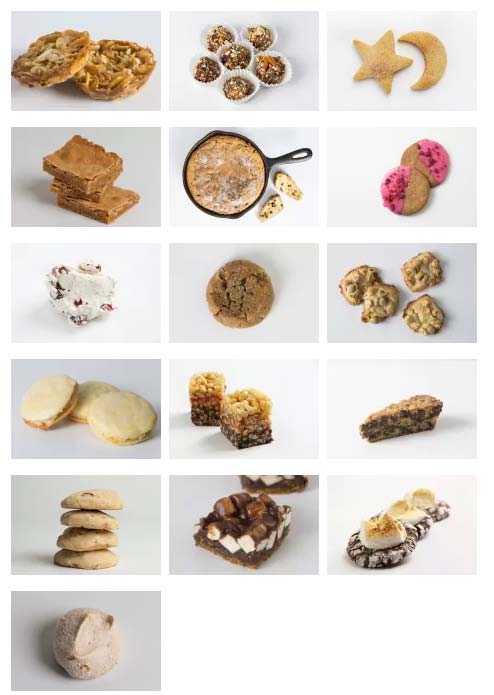
Attention, holiday bakers! While your ovens are preheating, take a quick spin through these reminders about ingredients and equipment. They'll help you bake your best cookies yet.
EGGS
• When you need to separate whites from yolks, do so when the eggs are cold. It will reduce the chances of yolk breakage.
• Eggs for beating into cookie doughs will incorporate more readily when they are at room temperature. Yolks = fat and richness; whites lighten the texture.
• Crack an egg open on the counter, not the edge of the bowl you're working in; this will help prevent any tiny bits of shell or broken yolk from getting into the mix.
• Most U.S. recipes rely on large eggs for baking, says Joy the Baker, even if they don't specify the size. A large egg translates to about 3 1/4 tablespoons; if you were to use extra-large or jumbo eggs instead of large, you would be adding substantially more liquid to the dough. (Yes, we know the Barefoot Contessa likes using extra-large eggs.)
BUTTER
• Grocery store packaged brands (in sticks) generally contain between 12 and 15 percent water, with a fat content between 77 and 80 percent. Premium butter brands have a higher fat content. Cookbook author Lisa Yockelson likes to use premium butter for bar cookies and dense cookie doughs, like shortbread; the national packaged stick brands for rolled cookies.
• When the recipe calls for melting butter, think about infusing it with a bay leaf as the butter cools. BAKING POWDER vs. BAKING SODA (for cookies)
• Baking powder (sodium bicarbonate plus tartaric acid) helps cookies expand or puff up. Baking soda (sodium bicarbonate) helps tenderize the dough and also provides a bit of leavening. Sifting or sprinkling these ingredients into the mix will help ensure an even interior crumb, says Joy the Baker.
NUTS
• Toasted/roasted nuts have more flavor. When you bring home fresh ones from the store, toss them on a baking sheet, roast, cool and stash in a container in the freezer until ready to use. This will save you time when you are baking in multiple batches.
• Bonus flavor: Drizzle them with melted butter before toasting; be sure to freeze or refrigerate once they have cooled.
UNBLEACHED OR BLEACHED FLOUR
• Unbleached all-purpose flour has more protein and weighs slightly more than bleached flour. So if you are able to use bleached flour for cookies, which will help make them more tender and may make colored doughs brighter, do so.
MIXING
• A mixture of butter and sugar that is overbeaten can result in cookie dough that spreads, says cookbook author and Paris food blogger David Lebovitz. Even when a recipe says to beat until fluffy or "cream the butter and sugar together," mix those two ingredients only until thoroughly blended.
WAX PAPER vs. PARCHMENT PAPER
• Both are nonstick, but they are not interchangeable. Wax paper is not heat-resistant, so do not use it to line baking sheets on which you are baking cookies. Use wax paper for rolling out and wrapping doughs, as a protective surface when you are decorating cookies, and to separate layers of cookies stored in containers. Use parchment paper for baking.
#40 DISHER
• This cookie scoop is popular with bakers because it yields consistent, 1 1/2 tablespoon-size mounds of dough. You can find the tool in kitchen stores and online for less than $10, making it a worthwhile investment. STORAGE
• Put a slice of fresh bread into the container with your cookies. That's the best way to keep them nice and moist, says Milk Bar's Christina Tosi. It will breathe new life into your cookies for three or four days.
• When you are defrosting baked/frozen cookies, open the lid or bag or wrapping slightly so condensation does not form.
PANS
• "Air-cushioned" baking sheets do not conduct heat especially well. Use heavy, light-colored ones when you can, or stack two lightweight pans on top of one another.
OVENS
• Make sure your oven temperature is accurate. Oven thermometers are inexpensive and helpful for monitoring. Consider getting the oven professionally calibrated before a big baking session if you are not able to adjust it yourself (check the manual).
• Hot spots and uneven heating are common in many home ovens, especially as the appliances age. That's why rotating baking sheets full of cookies halfway through the baking time is generally a good idea even when you are baking them one sheet at a time. A telltale sign: cookies on one part of the sheet are browning faster than the rest.
• For convection, the rule of thumb is to set a convection oven 25 degrees lower than for a conventional oven.
GLUTEN-FREE
• Two of the biggest concerns with gluten-free baking are cross-contamination and the use of ingredients with hidden gluten. If you are using a stand mixer that has had gluten flours or potentially contaminated ingredients in it, be sure to first properly wash and sanitize the machine's entire exterior. The same goes for measuring cups, baking pans and cooling racks.
• If your utensils are wooden or plastic and are well worn, consider buying new ones to use specifically for gluten-free baking.
• Gluten-free cookies should be packaged and plated separately from cookies containing gluten.
MISTAKES
• Failed cookies are almost always edible. Reduce them to crumbles and freeze for topping ice cream, sundaes or for creating parfait layers.


 Contact The Editor
Contact The Editor
 Articles By This Author
Articles By This Author